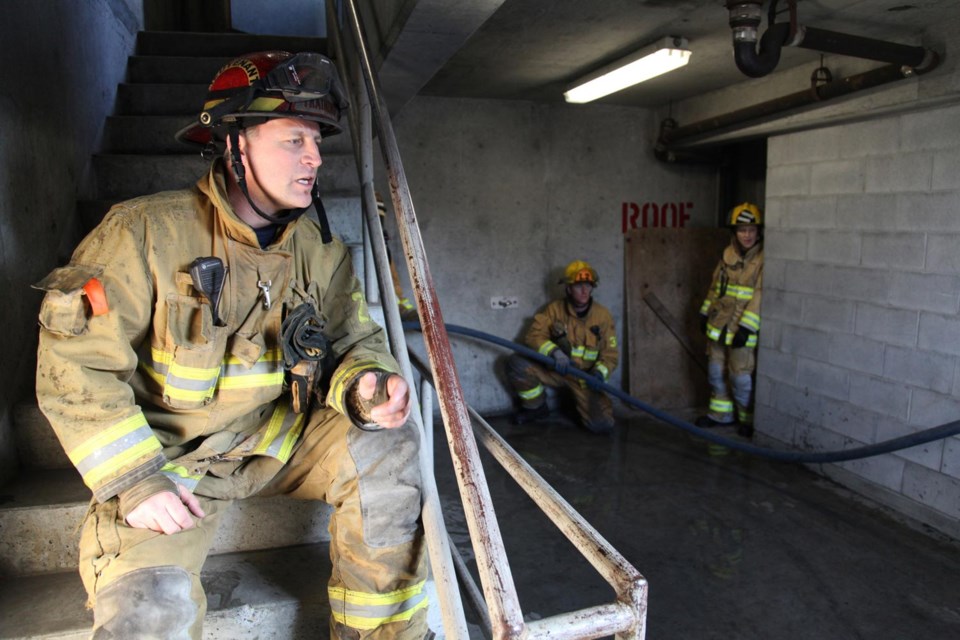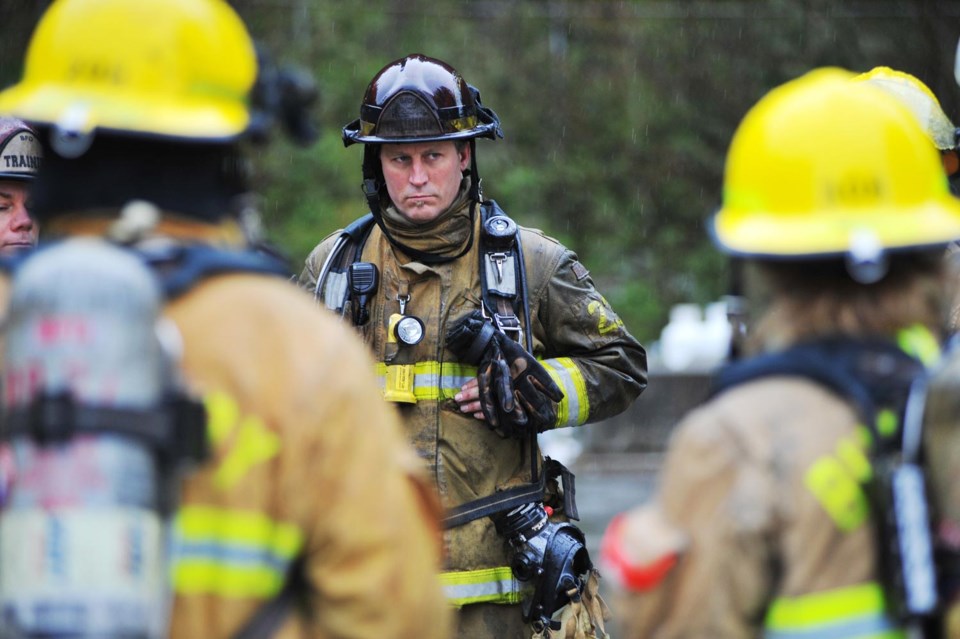For nearly 100 years, municipal firefighters in Burnaby have been putting out blazes across the city. From bush fires to motor vehicle accidents and everything in between, the department has grown by leaps and bounds since the early 1900s.
Today the department is made up of about 290 personnel led by fire Chief Doug McDonald, divided between seven stations throughout the city. Staff and personnel manage the department’s five divisions – administration, training, fire prevention, mechanical, and fire suppression – and most are specially trained to handle a variety of emergencies above and beyond basic structure fires.
Each year, the Burnaby Fire Department hires a new batch of recruits who undergo an intense application and interview process followed by nine weeks of fire training. While there aren’t many requirements to apply for the program, the department tends to choose candidates who have already attended fire school – either at the Justice Institute of B.C. in Maple Ridge or out-of-province locations.
The hiring staff at the department takes a lot into consideration when interviewing candidates. Things like community involvement and a team sports background are important qualities for candidates to have because it shows staff they enjoy helping others and are comfortable working in a group environment.
The recruitment process might seem excessive, but it’s not without cause, or results. The Burnaby Fire Department has become known as one of the leading departments in the province, which could be the reason firefighter hopefuls endure the lengthy, and sometimes gruelling, recruitment process.
With this in mind, reporter Cayley Dobie sat down with two Burnaby training officers, two of the department’s 2014 recruits and the director of the fire and safety division at the Justice Institute of B.C. to find out what all the fuss was about the Burnaby Fire Department.
Training intense – for good reasons
Running into a burning building where the list of unknown dangers is endless, isn’t a job for the faint of heart – in fact, it isn’t a job most people would ever consider doing.
But for Dave Samson, fighting fires is just another day at the office.
Samson is a captain with the Burnaby Fire Department and one of the training officers in charge of the 2014 recruitment program. For nine weeks, Samson and his training partner Lt. Darcy O’Riordan, prepared seven recruits for life as a firefighter. They trained them in the values of the department, fire station protocol and countless other technical skills they’ll need once they’re assigned a watch.

While the entire recruitment process, from application to training, can be an intense and exhausting experience, Samson says it’s like that for an important reason – to ensure the department is choosing the best people for the job.
Firefighting is a lifelong career, one that most people do for more than 30 years. The way Samson sees it is the new recruits are an investment the department makes – and, like any investor, they want the biggest return for the money and time.
The Burnaby NOW recently sat down with Samson to discuss what it’s like to become a Burnaby firefighter and why it’s such a grueling process.
Cayley Dobie: Describe the hiring process for firefighters in Burnaby.
Dave Samson: It is a lengthy process. How it starts is you apply through human resources at the city. A screening process will take place to make sure you meet all the minimum requirements and then there will be a panel interview with human resources and fire chief personnel. We’ll probably interview 50 to 60 candidates and then, out of those candidates,they’ll choose 20 to 24, and they’ll split those into two groups. So 10 to 12 will be assigned to work two Saturdays or two Sundays, we call those orientation weekends. During (the orientation weekends) they’re exposed to some basic firefighting skills, hose handling, ladders, and they’re being evaluated at all times as to how they do with their skill work, how they do with their interaction with others.
From then, what they’ll do is, what we call, the ride-along portion of our hiring process, and (the recruits) pick four days that work for them within a month period and they’ll go to work with certain fire halls, certain crews, and what they’ll end up with is four separate evaluations by four separate fire companies themselves – so it’s completely unbiased. After that there will be a physical abilities test.
CD:What is the purpose of all this testing?
DS:The committee that conducts the hiring will compile all the data from the orientation weekends, from the ride-a-long tests, from their physical abilities test and come up with some type of ranking system where we hash it out and then that goes off to the fire chief and then there is a final interview … with the fire chief.
CD:Did this year’s group go through the same process?
DS:This group here, they did go through the previous recruitment as well and out of that recruitment in 2011, six candidates were chosen and hired. But we felt this was still a really strong group and didn’t just want to cut them loose. They were put on an eligibility list so they didn’t have to go through a big recruitment process again. Out of that list there was, I think, 11 or 12 that were brought back just for another physical abilities test to see where they’re at, if they had progressed or regressed at all, and from there the recommendation was made to hire seven and they were the seven successful candidates.
CD: What’s the reasoning behind such an intense hiring process?
DS:To be honest, here at the Burnaby Fire Department we feel we have the best hiring process. Even though it’s lengthy and tough on the candidates, the end result is rewarding. Typically, firefighters work for more than 30 years so this isn’t just somebody who’s going to be around for a couple years, so we front-end load a lot of investment and time in evaluating in all the different facets of the job, not just their physical abilities but a lot of their ability to interact with others and with the public because that is a big part of the job.
CD:Is it important to get input from the department as a whole?
DS: There’s so many people that get touches on the process, so there’s really good involvement. It’s really important. We call ourselves second families around here, so we want to make sure we hire the appropriate people.
We get great buy-in by all the crews that do all the evaluating, and then they then feel they have a say in who they get to work with, it's just HR that does the hiring. That's why we do feel at Burnaby fire that we're leaders in that, and our fire chief supports us 100 per cent.



